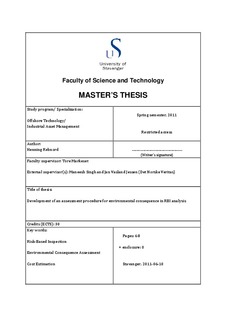| dc.description.abstract | Even with the recent developments in renewable energy, oil & gas are still our most important energy source today. This will also be the case in the foreseeable future, but new demands are constantly being forced on the industry. The need for hydrocarbons is recognized, but they are expected to be produced with minimal risk to operating personnel, company economy and the environment. The latter is the subject in this thesis, which aims to propose a new procedure to assess environmental consequence of failure within the discipline of risk-based inspection.
Risk-Based Inspection (RBI) is a formal approach developed to aid in the assessment of risk connected to the static equipment on a process plant, and to assign inspection intervals which give a good balance between safety, practicality and economy. The risk for each module is calculated using the probability of failure (PoF) and the consequence of failure (CoF). These two factors are combined to give a risk rating, which is then used to set an appropriate inspection interval for the module or component in question.
The consequence part of RBI is typically divided into three main categories: safety, cost and environment. Safety consequence is concerned with the possible injuries or fatalities in the case of an accident, while cost consequence covers the material damages, loss of production and reputation damage. The last category describes the consequence if the surrounding environment is exposed to spills or emissions.
The study presented in this thesis is partly based on existing literature, but the previous work in this area has proved to be limited. The environmental consequence has mostly been based on cost for clean-up, fines and penalties. The reason for this limited approach is probably the huge number of factors which could affect the environmental consequence from a spill. Detailed models exist, but they are too comprehensive to be applied in a practical RBI context.
In this thesis, factors influencing the environmental consequence of failure (E-CoF) are first identified and discussed. A procedure is then presented to assess the various factors and combine them into an E-CoF rating. The procedure is presented in the form of flowcharts, and a guide is provided to show the calculation of each contributing factor. As quantitative calculations are not always possible for RBI purposes, several methods for evaluation are presented for some of the factors.
The cost term has been left out of the E-CoF analysis, as it is difficult to compare cost to environmental harm. However, as costs are important, a separate procedure has been prepared for estimating the costs involved with a liquid hydrocarbon release. A matrix is also provided to allow combination of E-CoF and cost into a common consequence rating. | no_NO |
